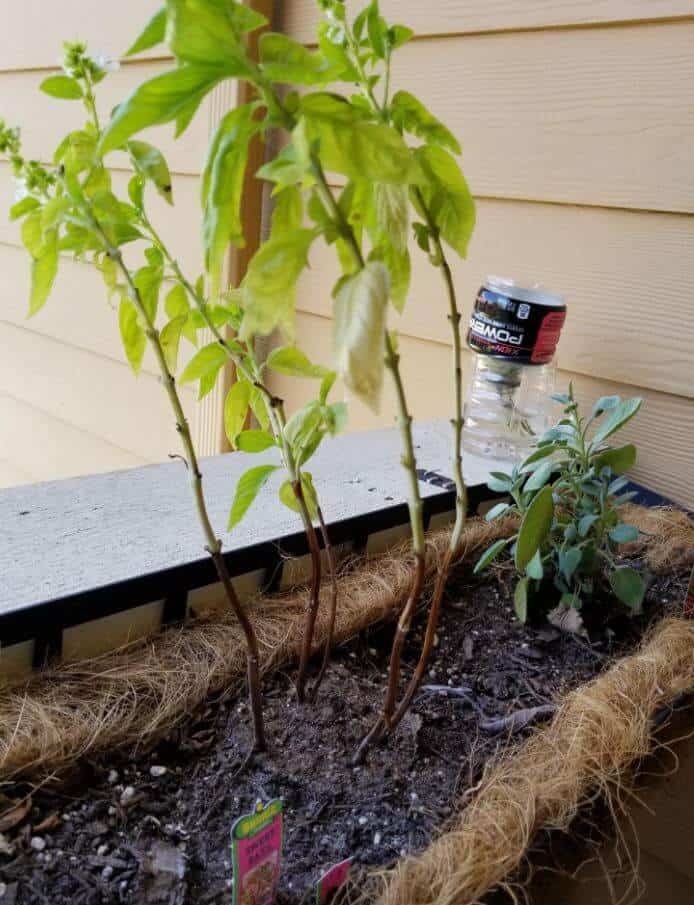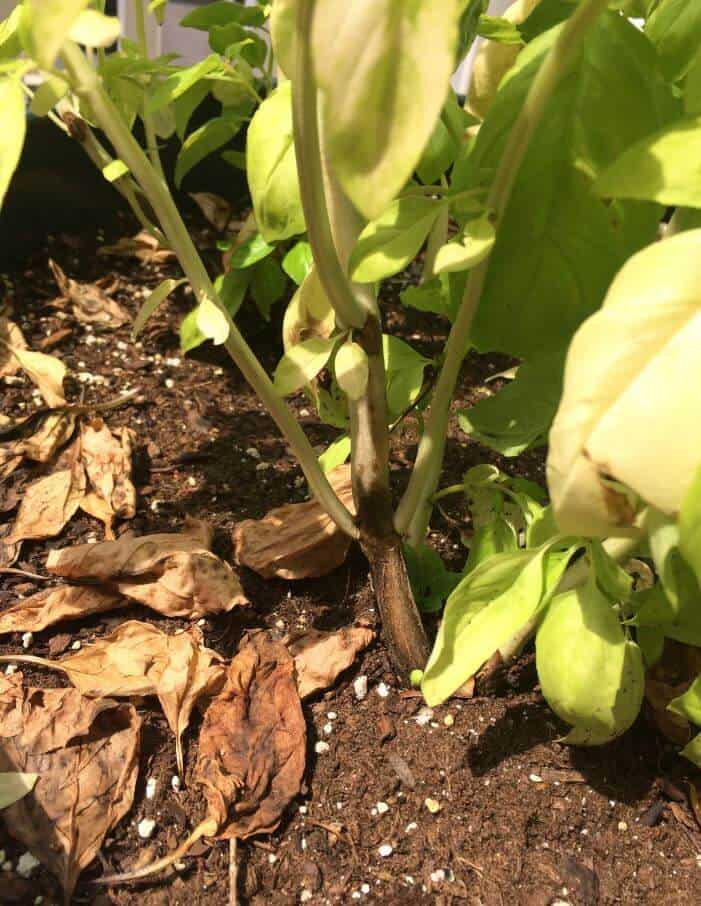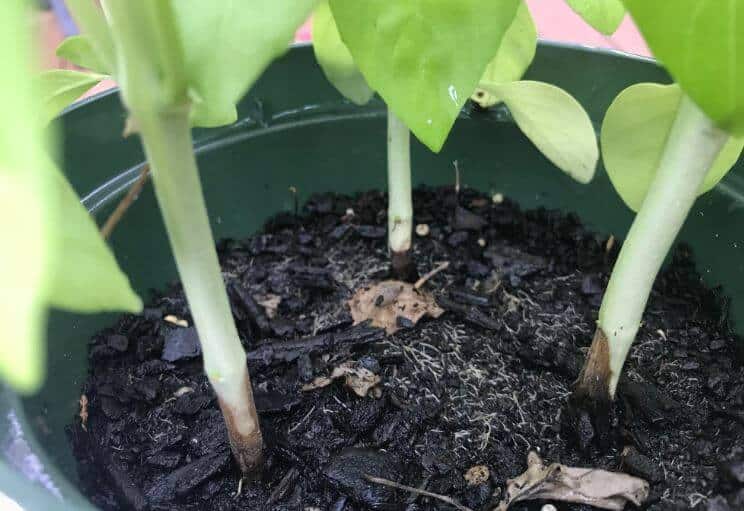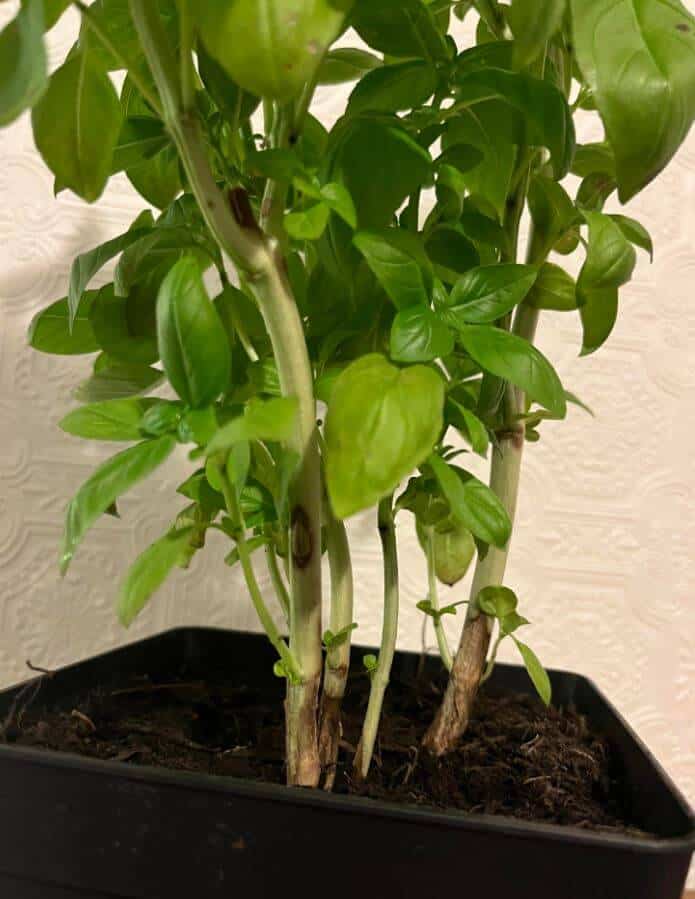Last Updated on August 28, 2023 by a Friendly Gardener
The basil plant is among the easiest plants to cultivate in home gardens. Nonetheless, this fragrant herb is quite susceptible to developing root rot thanks to fungus in soil beds that can strike when a plant is slightly weakened and unable to contrast fungal infections. Soil mixes without sufficient drainage or overwatering are generally the culprits, or a fungal infection may strike.
What is Root Rot?

The Fusarium wilt fungal disease often causes root rot due to Fusarium oxysporum present in soil. This fungus will overwinter in soil beds, waiting for wet, poorly draining soil conditions. The fungi will infect plant root systems. When this happens, it may be necessary to dispose of the plant and the soil or at least sterilize the soil. Plants and soil infected with basil root rot should not be composted but destroyed. Composting plants infected with Fusarium wilt risks spreading to other plants or parts of your garden.
Once the infection invades the root system and travels to the plant stem, water will no longer reach the entire plant, causing leaf discoloration, leaf curling, wilting, drooping, stem twisting, and leaf drop.
What Causes Basil Root Rot?

The two principal causes of basil plant root rot are fungal infection and overwatering. Overwatering may be a case of you providing too much water to the plant, or you may have a pot or soil mix that does not drain well.
Fusarium wilt is a common cause of rot found among members of the mint plant family. It is destructive and difficult to contrast, often resulting in the mandatory disposal of the plant and the destruction or sterilization of the infected soil.
Basil’s Biggest Threat: Fusarium Wilt

This highly invasive fungus can attack basil as early as the seed. If it successfully invades the seed, it will not impede the basil plant’s growth but will ruin it by stunting it and eventually prove fatal, killing your basil. Your plant may initially appear completely healthy; then, foliage will suddenly begin to yellow or brown. The plant will droop, and leaves may start to fall off. Severely infected plants may exhibit stem twisting, which is known as ‘shepherd’s crook’ and, as a symptom, confirms the presence of fusarium wilt.
This fungal infection invades the basil’s soft vascular tissue in the root system and then travels upward to stems and foliage. Once unleashed, it will block the plant’s water supply. Symptoms of vascular block include:
- curling leaves
- wilting
- leaf discoloration
- stem twisting
- leaf drop
At this point, you will need to destroy the plant. Basil plants that have contracted fusarium wilt cannot be saved.
Can Basil Recover from Root Rot?

When a soil mix is consistently moist, it encourages fungal spores to develop. If you are container cultivating a single basil plant that has been overwatered, there is a chance of saving it. If you are growing basil on an outdoor patch of land infected with Fusarium wilt, you may be unable to preserve something of your basil crop.
-
Treating basil root rot from overwatering
If your soil is soggy, a basil root rot fix is to prune your plant and change the soil. Remove your plant from its container, and using sterile gardening shears, trim off all infected roots that appear brown and mushy. Healthy basil plants have white root systems.
Prune all infected plant parts. Separate the remaining healthy plant into several smaller plants and repot each plant section in smaller, sterile four-inch pots with drainage holes and a loose, well-draining potting mix. If you have been cultivating more than one basil plant in your gardening pot, when repotting, make sure you leave a space of approximately one foot between the individual plants. Placing them too closely will encourage them to compete for soil nutrients, causing them to suffer.
-
Cultivating basil outdoors as a crop
If you have been cultivating basil in your outdoor garden, you must rotate crops annually. If you do not practice crop rotation, there is a greater risk of Fusarium wilt developing.
Once fusarium wilt is present within a soil bed, it can survive from eight to ten years, meaning that basil or other mint family members cannot be planted there. This includes solanaceous plants like eggplants, tomatoes, or potatoes.
Preventing Basil Root Rot

The best thing you can do is use an appropriate watering schedule. When cultivating basil plants indoors, you can water them every other day or every third day. Outdoor basil crops can be managed with weekly watering, especially if you get a bit of rainfall in your area.
Root rot develops when soil is water-laden, soggy, saturated, or too moist for too long. When temperatures rise, do not assume that your plant needs more water. Test the soil bed by poking a finger to verify if the soil has dried out or is still moist before watering again.
The only means of preventing Fusarium wilt is through crop rotation. If there is evidence of this fungal infection in a soil patch, avoid planting soft-stemmed crops there. If you suspect the soil has been contaminated, you can attempt to reclaim it; however, simply applying a fungicide will be insufficient.
You will need to use heat to reclaim infected soil. Soil temperature will need to be raised to between 95° and 140°F. To do so, position a colored tarp over the soil patch, as this will attract the sun’s heat and raise the soil temperature to kill the fungus.
A Final Attempt
In the event of root rot basil may be saved if the entire plant is not entirely ruined, you can attempt to propagate new plants from healthy stem cuttings. You will need a healthy stem cutting that is four to six inches long. The leaves from the lower third of the stem should be removed, and you can place your cutting in fresh, moistened soil in a warm, sunny spot. Within two to four weeks, new roots should begin to develop. Care for your new plantlets as you would mature basil plants.

